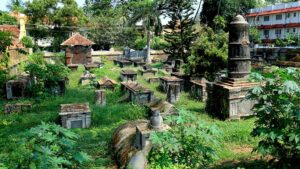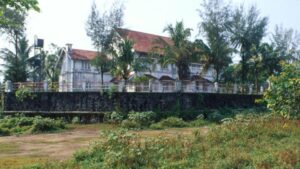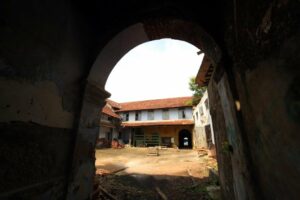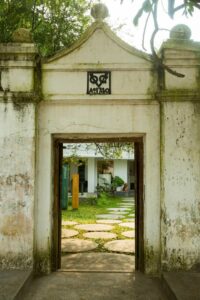 Whats New: Check EVENTS to sign up for art workshops, Janal Talks, Film Screenings & More!
Whats New: Check EVENTS to sign up for art workshops, Janal Talks, Film Screenings & More!  Whats New: Check EVENTS to sign up for art workshops, Janal Talks, Film Screenings & More!
Whats New: Check EVENTS to sign up for art workshops, Janal Talks, Film Screenings & More! Nestled on the western coast of India lies the “Queen of the Arabian Sea”, Fort Kochi. The trees sway and the cool breeze hits your face as you walk around this quaint land. With every step you take, you get transported to moments in time, all etched in stone. Holding a diverse history, the beauty is immense. Remnants of the Portuguese, British, Dutch sprinkled across the streets with their peculiar styles. While each had their own great importance, they together formed this parallel harmonization that cannot be found elsewhere.
The Dutch hold a very important place in the History of Kochi. The Dutch were the second colonial power to establish a ruling system in Kerala. It was the profit of the Portuguese from the trade with Kerala that attracted the Dutch here. The Dutch East India Company was established in 1602. Admiral Stephen Vander Hagen reached Calicut as the representative of the company and formed an alliance with the Zamorin, laying the foundation of the Dutch era in Kerala history.
The Dutch formed many treaties with local kings in central Kerala. They also went on to capture many Portuguese centres in Ceylon. In 1658, the Dutch captured Kollam and in 1663, Kochi from the Portuguese. In the early 18th century, Travancore became powerful under the rule ofMarthanda Varma. It annoyed the Dutch and in 1741, a large group of soldiers reached Kulachaland moved to Marthanda Varma’s capital, Kalkkulam. The following war witnessed the abysmal defeat of the Dutch. The Battle of Kulachal virtually brought an end to the Dutch dominance in Kerala. In 1795, the British also defeated the Dutch in a battle at Kochi, ending the Dutch influence absolutely.
The Dutch, even though long gone, has left a great imprint that is visible even today. They influenced history, life and culture. Let’s look at their contribution to the architectural remnants that exist in Fort Kochi even today.
➢ David Hall: One of the hallmarks in Fort Kochi, it stands as a glorious reminder of the Dutch era. Right around the Parade Ground, the history and architectural grandeur of the halls woo many visitors. It also houses an art gallery and acts as a cultural centre to support young exponents of visual and performing art forms.

DAVID HALL
Built in 1695 by the Dutch East India Company, it was a residence for the governor Hendrick Adrian Van Rheede tot Drakenstein. However, the building gets its name from a later occupant, a Jewish businessman called David Koder. During their rule over Kochi, the Dutch established a close relationship with the Jews as a trading community. This relationship is possibly what led to the building being handed over to a Jewish family and David Hall is thought to represent the Dutch-Jewish friendship that was a part of the history of Kochi. The building is a classic example of Dutch architecture. The wooden roof resembles an upturned hill with a droop supported by trusses, and the windows have four columns. One can see a well-maintained garden with huge, old trees in the courtyard.
➢ Dutch Cemetery: Running parallel to the beach, lies what is supposedly the oldest cemetery in the county. The Dutch Cemetery was consecrated in 1724. The cemetery, built in the style of the Dutch architecture of the time, is surrounded by walls and the year 1724 is engraved on the entrance pillar. The epitaphs and tombs, numbering 104, carry the authentic records of hundreds of people of Dutch and British nationality. Many of the tombs are made of granite and red laterite and have no cross. A unique feature of the tombs is that none of them displays a cross, unlike modern tombs in the area which has a Christian presence. Both the big and small tombs resemble the Dutch architecture of the eighteenth century. The inscriptions use an archaic Dutch text.

DUTCH CEMETERY
The cemetery is now managed by the Church of South India (CSI). The St. Francis CSIChurch of Fort Kochi maintains a record of the people buried here. According to T W Venn, who published the book St Francis Church, Cochin, the last person who was laid to rest in this cemetery was Captain Joseph Ethelbert Winckler. His burial took place in 1913.
➢Thakur House: Thakur House, on Dutch Cemetery Road, is another building that reflects the glory of a bygone era. It was built on Gelderland bastion and was earlier known as Kunal or Hill Bungalow. The house, atop a cliff facing the sea, has been an important landmark of Fort Kochi for centuries. The house reflects the luxurious lifestyle of the colonial era. It has vast lawns and the sea breeze keeps the house very cool. This house built in the 1700s is a monument of Dutch architecture with wooden floors, spacious rooms, and bay windows. It is a two-storied building and there is remarkable symmetry between the two floors. The original building had several verandas and a hall. Alterations were done to the building by the various occupants of the house. Glass lamps hang from the roof beam and crystal and earthen pottery adorn the shelves and tables – all providing a colonial grandeur to the building. Several paintings decorate the walls of the rooms.

THAKUR HOUSE
During the 17th century, the building, on account of its strategic position, served as a prominent look-out point near the Cochin Harbour. It is believed that the house has several tunnels leading to far-off places in Fort Kochi such as the St. Francis Church and Bishop’s House. The Dutch built the Thakur House as a club and community centre for the Dutch East India Company. During the last decades of the 19th century, the bungalow was occupied by a prominent spice trading family of Mattancherry. In the early 1900s, it was used as lodging for the managers of the National Bank of India. The ownership of the bungalow again changed hands and went to a well-known tea-trading firm.
➢ Dutch Warehouse: After conquering Kochi in the 1660s, the Dutch continued to use the flourishing land and trade for their benefits, as anybody else would. A big part of trade includes warehouses and storage spaces. The warehouses they built were crucial for this trade, and a few of these structures still stand along the coast of the Vembanad lake, the place where the river Periyar flows into the Arabian sea. The warehouses, usually featuring a central courtyard surrounded by rooms on all four sides, would have jetties with docks facing the lake. This is where goods would be brought in, on boats and transferred to foreign ships that plied this trade route. Used as storage facilities, they usually housed items like pepper, spices, and other various things brought from parts of Kerala, until they were shipped off. This Dutch Warehouse is one of these buildings. Closed to the public in general, it has been used as a venue by the Kochi-Muziris Biennale in the past.

DUTCH WAREHOUSE
➢ VOC Gate: The Parade Ground, spanning over 4 acres of land, is a well-known landmark. As the name suggests, it was used for parading and military purposes by the colonials. Being dotted with many other historical sites around it, one such silent and yet important monument stands, in the form of a Gate. VOC gate got its name from the monogram ‘VOC’ carved on it. VOC stands for ‘Vereenigde Oostindische Compagnie’ which means ‘United East India Company’. This was built by the Dutch East India Company in the year 1740. In the 17th Century, the Dutch East India Company was the richest private company in the world. VOC gate is a testament to the trade links between the Dutch and the Kingdom of Kochi.VOC gate and the building adjacent to it were both parts of the Dutch fort.VOC was a powerful company that had the authority to strike its own coins. VOC was originally a chartered company established in 1602 and was the first company to issue stock. The Dutch Government granted the company a 21-year monopoly on the Dutch spice trade. The Company was conferred authority to wage war, imprison and execute convicts, and negotiate treaties. It is often considered to have been the first multinational corporation in the world. Today, VOC gate is a part of a hotel owned by a private company, which also has a restaurant and a coffee shop.

VOC GATE
Holding so much history in their walls, these monuments stand as a testament to the Dutch and their work. Embedded in stone, the legacy of the colonial powers dots Kochi, drawing a beautiful connection of a world gone. Even today, the atmosphere of the amalgamation of local to these buildings stand out and cause a beautiful scene.
References:
Get exciting updates about our events and more